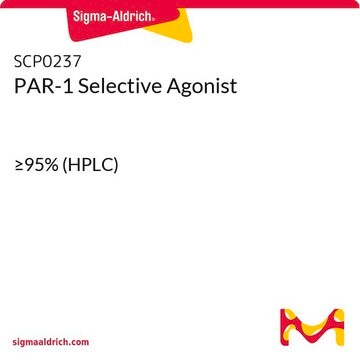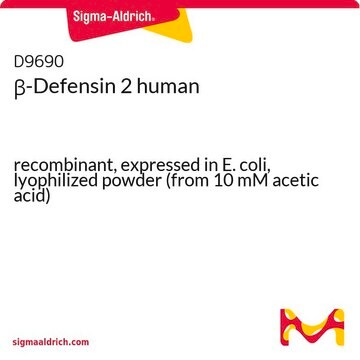Kluczowe dokumenty
T7830
TFLLR-NH2 trifluoroacetate salt
>98% (HPLC)
Synonim(y):
L-Threonyl-L-phenylalanyl-L-leucyl-L-leucyl- L-argininamide trifluoroacetate salt, Thr-Phe-Leu-Leu-Arg-NH2 trifluoroacetate salt
Wybierz wielkość
620,00 zł
Wybierz wielkość
About This Item
620,00 zł
Polecane produkty
Próba
>98% (HPLC)
Formularz
lyophilized powder
kolor
white to tan
rozpuszczalność
H2O: >2 mg/mL
temp. przechowywania
−20°C
ciąg SMILES
OC(=O)C(F)(F)F.CC(C)C[C@H](NC(=O)[C@H](CC(C)C)NC(=O)[C@H](Cc1ccccc1)NC(=O)[C@@H](N)[C@@H](C)O)C(=O)N[C@@H](CCCNC(N)=N)C(N)=O
InChI
1S/C31H53N9O6.C2HF3O2/c1-17(2)14-22(27(43)37-21(26(33)42)12-9-13-36-31(34)35)38-28(44)23(15-18(3)4)39-29(45)24(16-20-10-7-6-8-11-20)40-30(46)25(32)19(5)41;3-2(4,5)1(6)7/h6-8,10-11,17-19,21-25,41H,9,12-16,32H2,1-5H3,(H2,33,42)(H,37,43)(H,38,44)(H,39,45)(H,40,46)(H4,34,35,36);(H,6,7)/t19-,21+,22+,23+,24+,25+;/m1./s1
Klucz InChI
QVNWOGSDGQDGHP-MKVNCOEFSA-N
Amino Acid Sequence
Zastosowanie
Działania biochem./fizjol.
Uwaga dotycząca przygotowania
Kod klasy składowania
11 - Combustible Solids
Klasa zagrożenia wodnego (WGK)
WGK 3
Temperatura zapłonu (°F)
Not applicable
Temperatura zapłonu (°C)
Not applicable
Wybierz jedną z najnowszych wersji:
Certyfikaty analizy (CoA)
Nie widzisz odpowiedniej wersji?
Jeśli potrzebujesz konkretnej wersji, możesz wyszukać konkretny certyfikat według numeru partii lub serii.
Masz już ten produkt?
Dokumenty związane z niedawno zakupionymi produktami zostały zamieszczone w Bibliotece dokumentów.
Klienci oglądali również te produkty
Active Filters
Nasz zespół naukowców ma doświadczenie we wszystkich obszarach badań, w tym w naukach przyrodniczych, materiałoznawstwie, syntezie chemicznej, chromatografii, analityce i wielu innych dziedzinach.
Skontaktuj się z zespołem ds. pomocy technicznej








